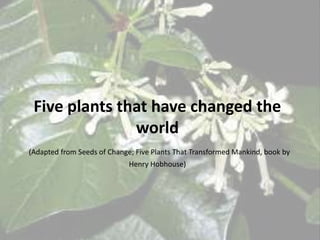Report
Share

More Related Content
Similar to Plants that have changed the world
Similar to Plants that have changed the world (20)
Origin, TAXONOMY, cytogenetics and evolution of arachis

Origin, TAXONOMY, cytogenetics and evolution of arachis
More from carissaf (16)
Saps auxin investigations - effects of iaa on root growth - students guide

Saps auxin investigations - effects of iaa on root growth - students guide
Plants that have changed the world
- 1. Five plants that have changed the world (Adapted from Seeds of Change; Five Plants That Transformed Mankind, book by Henry Hobhouse)
- 2. Quinine Chinchona sp. Quinine Discovered by the Quechua, who are indigenous to Peru and Bolivia; later, the Jesuits were the first to bring cinchona to Europe. Enabling Europeans to move into Malarial regions and colonise parts of the world.
- 3. Sugar cane (Saccharum sp.) Tropical, perennial grass, forms lateral shoots at the base to produce multiple stems, Typically 3-4 metres high and about 5 cm in diameter. The stems grow into cane stalk, which when mature constitutes approximately 75% of the entire plant. A mature stalk is typically composed of 11–16% fibre, 12–16% soluble sugars, 2–3% non- sugars, and 63–73% water.
- 4. Cocaine (Erythroxylum coca) Psychoactive alkaloid